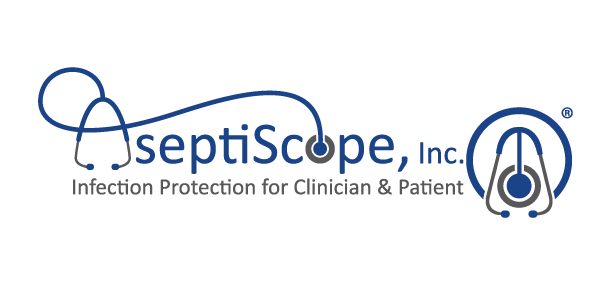- Growing awareness of the stethoscope as a potent vector for pathogen transmission will increase the frequency of related healthcare acquired infection malpractice litigation
- Authors call for updated stethoscope hygiene guidelines from the Centers for Disease Control and adoption of innovative technologies, like The DiskCover™ System from AseptiScope®, Inc, to bolster both patient safety and clinician accountability
August 5, 2021, San Diego, CA – A new article in the American Heart Journal Plus: Cardiology Research and Practice entitled “Stethoscope hygiene: A legal consideration for cardiologists practicing in a new era of infection control (COVID-19)” highlights increasing awareness of the threat that contaminated stethoscopes pose to patients for healthcare associated infections and the corresponding medical liability risk faced by healthcare providers.
Among the co-authors of the article is Alpesh Amin, MD, a leading investigator who, in 2015, published a study entitled “The Third Hand: Low Rates of Stethoscope Hygiene on General Medical Services” and is a leading voice in a growing consensus of experts publicly calling on the CDC to elevate stethoscope contamination risk as a nationally significant health concern. “Failure to perform effective stethoscope hygiene between patients utterly undermines our hand hygiene efforts and practices,” said Dr. Amin. “With today’s advancements in technology, we have an opportunity in the field of stethoscope hygiene to set new expectations and standards while taking important strides towards the ‘Triple Aim,’ realizing reduced costs, an improved patient experience, and improved overall health for our hospitalized patients,” Dr. Amin added.
Dan Hannula, a co-author and medical malpractice legal expert, agrees with Dr. Amin on the potential vulnerability of healthcare providers. “The medical community focuses considerable time and energy on protocols that ensure hygiene for the clinician’s physical hands, yet there is an uncomfortable silence when it comes to equivalent efforts for the stethoscope, their third hand, which is just as contaminated and moves from one sick patient to the next usually without vigilance,” Mr. Hannula stated. “In a world where awareness of stethoscope contamination is now so high and innovative solutions are available to address it, hygiene protocols must be deployed to reduce both patient exposure to infection and provider exposure to liability,” said Mr. Hannula.
“At AseptiScope® we know that healthcare providers want to do the right thing, and everything they can, to protect their patients from infection,” said Scott Mader, the CEO and co-founder of AseptiScope. “With The DiskCover™ System, clinicians are, for the first time in an on-demand and touch-free fashion, able to instantly apply a single use, aseptic stethoscope diaphragm barrier for a clean auscultation of the patient. The system’s compact size allows for installation close to the point of care, something that our clinical customers tell us is critical to ensure compliance. Moreover, our users tell us that the system is effective, easy to use, presents no interruption to clinical workflow, and is seen as superior to current standard of care options.” Mader concluded.
About AseptiScope, Inc.
AseptiScope is a privately funded San Diego, California based, clinical innovation company formed in 2016. The organization is founded and led by clinical innovation experts, leading medical researchers, and practicing physicians. The AseptiScope mission is to design, develop, manufacture and commercialize novel solutions that ensure “Infection Protection for Clinician & Patient.” The company has introduced the first true solution for the longstanding challenge of stethoscope contamination: The DiskCover System. Visit www.diskcover.com for more information.
AseptiScope and related logos are registered trademarks of AseptiScope, Inc. DiskCover and related logos are trademarks of AseptiScope, Inc.
Media Contact:
AseptiScope Inc.
Irene Mulonni
irene@mulonni.com
858.859.7001
